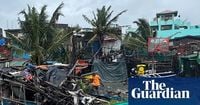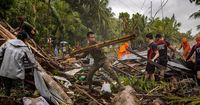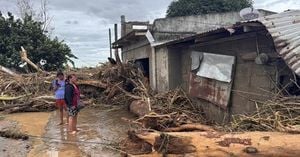As the sun rose over the battered coastline of Luzon on November 10, 2025, the Philippines was once again reckoning with the aftermath of a powerful storm. Typhoon Fung-wong, the 21st storm to strike the archipelago this year, had swept through the nation with a band of rain stretching a thousand miles wide, unleashing high waves, torrential rain, and winds that locals described as deafening—"probably louder than an airplane," as one resident put it (according to The New York Times).
The typhoon made landfall on Sunday evening in Aurora Province, located on the country’s main island of Luzon. By Monday, the storm’s impact was painfully clear: at least two people had lost their lives, and over 1.4 million others were forced to flee their homes, according to figures reported by NPR and ABC News. Some agencies, including ABC News, cited the death toll as high as four, but the consensus among local officials and multiple news outlets was that the toll remained mercifully low—especially compared to the devastation wrought just one week earlier by Typhoon Kalmaegi, which killed more than 200 people.
For many Filipinos, the storm’s arrival was a haunting echo of recent tragedy. Ivy Villamor, a resident of Sinbanali—a seaside village near Manila—recounted the terror that gripped her family as the winds howled and the rain pounded relentlessly. “We did not want to be swept to sea, so we rushed here,” she told The New York Times over an “evacuation breakfast” of instant noodles, hot dogs, and eggs at Bacoor Elementary School, which had been transformed into a makeshift refuge for nearly 1,000 villagers.
Villamor’s daughter, Nicole, sat quietly beside her, while her husband braved the storm’s aftermath to check if their hut had survived. The family’s story was echoed by many others. Jessica Amposta, who had evacuated three times in the past year, described the fear and resignation that comes with living in one of the world’s most disaster-prone countries. “We’re used to it. This is a bad cycle of events for us,” she said. “The heavy rains were scary. The water rose quickly, and the monitors said it was waist-deep in our home in a matter of hours.”
Analyn Benairez, 25, initially tried to hold out at home but relented as the water kept rising. “At first, we didn’t want to leave, but we remembered what happened in Cebu. I thought of my son. If the waters come, we’re in trouble because none of us know how to swim.” Her husband, Jerome, added that by the time they evacuated, the floodwaters had already reached his waist.
These stories of rapid, harrowing evacuation were repeated across Luzon and beyond. The government, having learned hard lessons from previous disasters, had preemptively evacuated more than 1.3 million people before Fung-wong made landfall, according to The New York Times. President Ferdinand Marcos Jr. personally urged residents to heed emergency protocols, a move that officials say likely saved countless lives. Bernardino Rafaelito Alejandro IV, deputy administrator at the Office of Civil Defense, reported that approximately 1,000 homes had been damaged and 132 villages flooded. "There have been reported storm surges in coastal communities, then a number of landslides," Alejandro said, noting that some areas remained isolated due to debris blocking roads. Cleanup efforts, he promised, would begin immediately.
International organizations also played a crucial role in the country’s disaster response. Regis Chapman, country director of the World Food Programme (WFP) in the Philippines, told NPR that the agency had anticipated the typhoon’s impact and moved swiftly to preposition government food packs. In a proactive measure, the WFP also provided cash transfers to around 40,000 households before the storm hit, enabling families to take preparedness steps on their own. “What’s been really quite an interesting one with this response is we were also able to make transfers to around 40,000 households to provide them with the cash they need to be able to take preparedness measures,” Chapman explained. Such early intervention, he said, is not only more effective but also more cost-efficient than traditional post-disaster relief.
Despite these efforts, the scale of displacement was staggering. More than 1.4 million people were uprooted from their homes, with about a million ordered to evacuate as the typhoon approached, according to NPR. Many evacuees found shelter in schools, government buildings, and churches, clutching what few belongings they could carry. The storm left behind a trail of damaged homes, ruined crops, and flooded streets. In Sinbanali and other low-lying communities, families waded through waist-deep water, praying for the safety of loved ones and the resilience to rebuild.
The storm’s relatively low death toll—especially in comparison to Typhoon Kalmaegi’s devastation—was a testament to both government action and the grim familiarity Filipinos have developed with such crises. Chapman, of the WFP, noted that the Philippines is “the most disaster-prone country in the world.” He argued that the solution lies in strengthening resilience at both the government and household levels, allowing for quicker, more robust responses to inevitable future storms. “That resilience needs to be of government systems to be able to scale up and respond and to support preparedness, but also vulnerable households to, you know, have more resilience at their level, as well,” he said.
Even as Fung-wong moved out to sea, the threat was not over. Authorities warned that the typhoon would continue to bring heavy rains to Luzon, raising the risk of further flooding and landslides. Nearly a thousand search-and-rescue teams had been deployed in anticipation of the storm, working around the clock to assist affected communities and restore access to isolated areas.
The frequency and severity of such storms have become a grim routine. Typhoon Fung-wong was the 21st named storm to hit the Philippines in 2025 alone, a statistic that underscores the country’s vulnerability to climate-driven disasters. As BBC Verify Live reported, footage of Fung-wong’s devastation made headlines around the world, highlighting both the resilience of the Filipino people and the relentless challenges they face.
For families like the Villamors, Ampostas, and Benairezes, the storm’s passing marks just another chapter in an ongoing struggle. As they share meals in crowded evacuation centers and wait for floodwaters to recede, there is relief—yes, and gratitude for survival—but also a weary recognition that, in this part of the world, the next storm is never far away.







